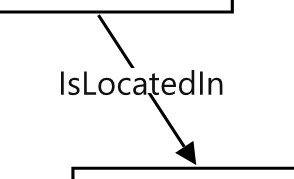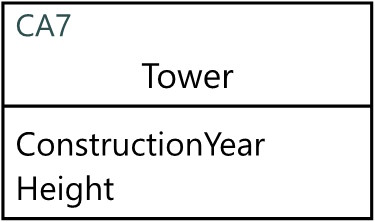LogosLink User's Manual
·
LogosLink version 2.2.0
Ontology Elements
Ontology elements are the atomic components of an ontology.
There are multiple kinds of ontology elements.
In addition, ontology elements are connected via relationships, forming a mesh that you can navigate and explore.
Details
There are multiple kinds of ontology elements, which are described in the following sections.
Every ontology element, no matter of what kind, has an identifier, which unequivocally distinguishes it from other elements.
There are different kinds of concepts in an ontology.
Entities represent independent things in the world.
There are two kinds of entities in an ontology: atoms and categories.
Atoms represent individual things, whereas categories represent kinds of things.
Entities are complemented by values, links, properties and associations.
Atoms, together with values, references and links, are called instances, because they represent individual things in the world.
For example, the song "Wuthering Heights" can be represented in an ontology by an atom plus a few values to represent its characteristics such as its title, year of release and genre.
Furthermore, this atom can contain some references to link it to other atoms such as its author or the album in which it was included.
On the other hand, categories, properties, connections and associations are collectively called types, because they represent kinds of things in the world.
For example, an ontology about pop music may contain a Song category to represent songs, plus a few properties to capture the fact that every song has a title, a duration and a genre.
The Song category may also have a few associations to connect with related categories, such as Author or Studio.
Furthermore, categories, like atoms, can have values and references too.
Instances and types form "parallel" descriptions of the world at different levels.
They can be related via instance/type relationships, so that:
-
Each atom can be related to a category of which it is an instance.
For example, the atom WutheringHeights, which represents the song "Wuthering Heights", is an instance of the Song category, thus indicating that it is of the type Song.
-
Each value is related to a property of which it is an instance.
For example, the value YearOfRelease = 1978 in the WutheringHeights atom is an instance of the YearOfRelease property of the Song category.
-
Each link is related to an association, of which it is an instance.
For example, the link that connects author KateBush to the WutheringHeights song is an instance of the association that connects the Author and Song categories.
The following sections provide more details.
A denotation is a connection between a fragment of the ontology text content and a concept.
For example, the text fragment "Clinton" may denote the Bill Clinton atom in the ontology.
An atom represents an individual thing in the world, such as the Eiffel Tower, the song "Wuthering Heights", or yourself.
Atoms have a name, such as EiffelTower, plus optional phase and perspective qualifiers, which are useful to specify when and according to whom the atom exists.
Atoms may also have values and linkes to other atoms (see below).
An atom can be an instance of a category.
For example, the EiffelTower atom may be an instance of the Tower category in the ontology.
This is optional, and you can have atoms without a category, although there are some limitations for them.
 Atoms are shown in the Ontology window as rectangles with an upper section containing the name and type, plus a bottom section containing the associated values.
Atoms are shown in the Ontology window as rectangles with an upper section containing the name and type, plus a bottom section containing the associated values.
A value represents an individual characteristic of a thing in the world.
Any entity, no matter whether it is an atom or a category, can have values.
For example, the EiffelTower atom, which represents the Eiffel Tower, may have a value ConstructionYear = 1889 to capture the fact that the tower was constructed in 1889.
The "1889" piece of data is called the content of the value.
Additionally, values may have optional phase and perspective qualifiers, which are useful to specify when and according to whom the value is valid.
Every value is an instance of a property of the atom's category.
This means that atoms with no category cannot have values.
For example, the ConstructionYear = 1889 value of the EiffelTower atom is an instance of the ConstructionYear property of the Tower category.
A reference represents an individual relationship of a thing in the world towards another thing in the world.
Any entity, no matter whether it is an atom or a category, can have references.
For example, the EiffelTower atom, which represents the Eiffel Tower, may have a reference Location = Paris to capture the fact that the tower is located in Paris.
In this example, "Paris" is another atom in the ontology.
The "Paris" piece of data is called the opposite entity of the reference.
 References are shown in the Ontology window as straight lines with a small arrow head.
References are shown in the Ontology window as straight lines with a small arrow head.
Additionally, references may have optional phase and perspective qualifiers, which are useful to specify when and according to whom the reference is valid.
Every reference is an instance of a connection of the atom's category.
This means that atoms with no category cannot have references.
For example, the Location = Paris reference of the EiffelTower atom is an instance of the Location connection of the Tower category.
References are directed, that is, they go from one source entity to a target one.
Every reference has an inverse one, that connects the same two entities in the opposite direction.
This pair of references is called a link.
A category represents an abstract kind of thing in the world, such as the Tower category representing towers of interest, or Song to represent relevant songs.
Categories have a name, such as Tower, plus optional phase and perspective qualifiers, which are useful to specify when and according to whom the category exists.
Categories may also have values and references (see above), as well as properties and associations (see below).
A category can work as the type of atoms, which are its instances.
For example, the EiffelTower and LeaningTowerOfPisa atoms can be instances of the Tower category in the ontology.
This is optional, and you can have atoms without a category or a category with no atoms.
 Categories are shown in the Ontology window as rectangles with an upper section containing the name, plus a bottom section containing the associated properties.
Categories are shown in the Ontology window as rectangles with an upper section containing the name, plus a bottom section containing the associated properties.
Independently of the above, a category can be also an instance of another category.
For example, the OakTree and PineTree categories can be instances of the TreeSpecies category in the ontology.
Categories as instances of other categories is not a common modelling technique, and although it is very powerful, it can also get complicated.
In addition, categories may have subtypes and supertypes.
A subtype is another category that constitutes a particular subset of the main category.
For example, the Tower category can be a subtype of the Building category, as towers are a particular kind of buildings.
If a category has a subtype, then it becomes its supertype.
In the previous example, Building is the supertype of Tower.
 Sub-typing relationships are shown in the Ontology window as angled lines with a large triangular arrow head.
Sub-typing relationships are shown in the Ontology window as angled lines with a large triangular arrow head.
Values, references, properties and associations are inherited by subtypes from their supertypes.
For example, if the Building category has a Height property and Location association, then the Tower category inherits these, so that any instance atom of Tower can express its height and location too.
A property represents the fact that instances of a particular category may have values of a certain kind.
For example, the Tower category may have a ConstructionYear property to indicate that any tower has a particular construction year.
Properties work as types of values.
For example, the EiffelTower atom, being an instance of the Tower category, may have a value ConstructionYear = 1889 to indicate that it was constructed in 1889.
A connection represents the fact that instances of a particular category may refer to instances of another category in a particular way.
For example, the Tower category may have a Location connection towards the City category to indicate that any tower is located in a particular city.
Connections work as types of references.
For example, the EiffelTower atom, being an instance of the Tower category, may have a reference Location = Paris to indicate that it is located in Paris.
 Connections are shown in the Ontology window as angled lines with a small arrow head.
Connections are shown in the Ontology window as angled lines with a small arrow head.
Connections are directed, that is, they go from one source category to a target one.
Every connection has an inverse one, that connects the same two categories in the opposite direction.
This pair of connections is called an association.
Further information
A complete description of the different ontology elements doesn't fit here.
Please refer to the IAT/ML Technical Specification if you are interested in a complete technical description.
See Also
Contents distributed under a Creative Commons Attribution 4.0 International License
·
About
·
Terms of Use
·
Contact Us
·
last updated on 10/09/2025 10:52